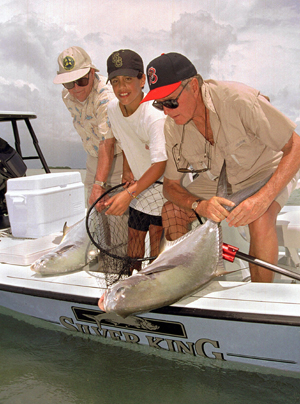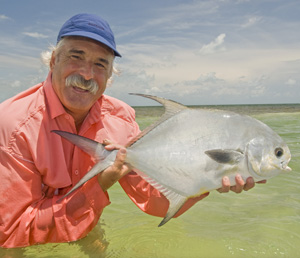Ever wondered about the history of environmentally responsible angling in the Florida Keys, and the catch-and-release principle that helps protect and preserve the island chain’s fish populations? Here guest blogger Doug Kelly, an acclaimed travel and outdoors writer and author of “Florida’s Fishing Legends and Pioneers,” provides insights into the subject.

President George H.W. Bush, right, and his grandson Jeb Bush Jr. release permit during a 1995 Islamorada tournament. At left is George Hommell, a longtime Florida Keys fishing guide. (Photo by Andy Newman, Florida Keys News Bureau)
Pop balladeer Engelbert Humperdinck certainly didn’t have fish in mind when he sang his hit song, “Please Release Me,” but it’s an appropriate soundtrack for modern-day angling.
In 1939 Florida Keys fishing guide Bill Smith discovered a new game in town: catching bonefish with fly-fishing gear. Up until then, no one thought that targeting the species on fly was possible.
The word slowly leaked out to the rest of the world until it reached the ears of Bernard “Lefty” Kreh in 1951. Kreh (pronounced CRAY), a budding newspaper writer from Maryland with a knack for fly fishing, arranged a trip to the Keys to fish with Captain Smith.
After several days of fly fishing, Kreh had racked up catch after catch of bonefish. He also battled tarpon, snook, trout and redfish. On traditional tackle offshore, Kreh reeled in reef fish and billfish. It was the good ol’ days of Keys fishing.
In the ensuing decades, word spread like wildfire via television shows, magazines and newspapers extolling the bounty of Florida Keys offshore and light-tackle fishing. Anglers flooded the Keys, and inevitably the increased pressure put a dent in the Keys’ resources as well as other saltwater fishery habitats around the world.
Kreh recognized the drop in numbers of fish, as did veteran Florida Keys guides such as Jimmie Albright and Cecil Keith. They arrived at the only sensible answer: anglers needed to keep fewer fish. It made no sense to overfill ice chests just for the purpose of “feeding the neighbors.”
Fishing journalists started pushing a more conservation-focused angle. Government fisheries agencies implemented size and bag limits. Captains began to understand the need for conservation and counseled their clients accordingly. Piles of carcasses on the dock or freezer-burned fillets soon became passé.
But transcending reduced catches evolved an even mightier mentality: catch-and-release fishing. Particularly for species not considered dinner fare, such as bonefish and tarpon, heck … let them all go. In that way, more fish will breed and grow to larger sizes.

Most Keys anglers, like Doug Easter here, releases their catches and believe “a fish is too valuable to be caught only once.” (Photo by Steve Bly, Florida Keys News Bureau)
It’s caught on (pun intended). Most anglers have now embraced the mantra that “a fish is too valuable to be caught only once.” And with the advent of digital cameras and the Internet, one can still score bragging rights on social media without killing a fish.
And taxidermists don’t need dead fish to create memorable fish mounts. An approximate length and girth is all that’s required for a beautiful and exacting fiberglass reproduction mount.
While conservation of fish didn’t originate in the Florida Keys, the region is now the world’s poster child for it. Even novice anglers release every bonefish, permit and tarpon — and while it’s delectable to enjoy a fish fillet now and then, all species are tightly regulated in Florida.
Proper ways to release fish can be found through a Google search, and barbless hooks or circle hooks are often employed to deter a fish swallowing the bait.
The welcome mat is out to experience the unparalleled bounty of fishing from Key Largo to Key West. But go about it with a catch-and-release mentality, because that’s why the good ol’ days of Keys fishing are here once again.

